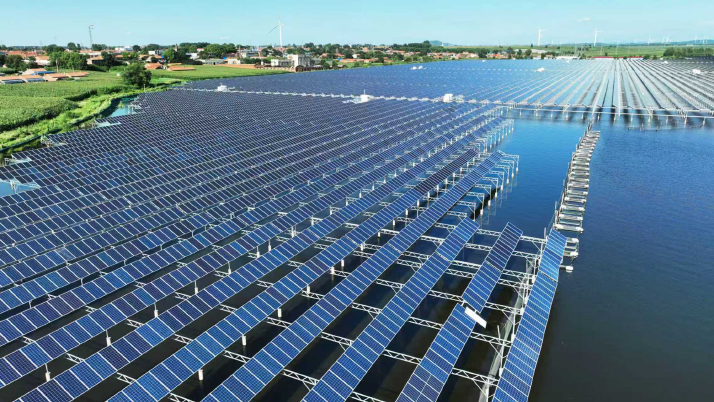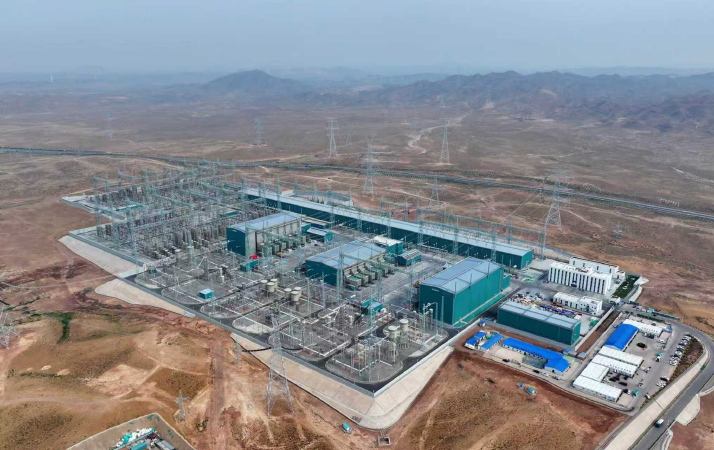| China |
| China's clean and low-carbon energy transition over the past five years | |
|
|
 Solar panels above a reservoir in Tieling County, Tieling City, Liaoning Province, on July 30 (XINHUA)
Substantial advancements have been made in China's energy sector during the 14th Five-Year Plan (2021-25) period, with green energy now accounting for one third of the nation's electricity consumption. Green energy is generated from natural resources such as sunlight, wind or water without producing any pollution or carbon emissions. At a press conference in Beijing on August 26, Wang Hongzhi, head of the National Energy Administration (NEA), characterized these developments as "breakthroughs and historical accomplishments," positioning China as a key facilitator of the global energy transition. The NEA data show the past five years have been defined by rapid green and low-carbon energy transition. Since the commencement of the 14th Five-Year Plan, the share of non-fossil energy in China's total energy consumption has increased by 1 percentage point annually, concurrently with a 1-percentage point annual decrease in the proportion from coal. Chen Li, chief economist of the Green Finance Research Center of China Huadian Corp. Ltd., a major state-owned power producer, described this trend in an interview with China Youth Daily as a profound energy revolution, indicating a substantive leap in China's energy system from a coal-dominated model to one emphasizing diversified and clean energy sources.  The Zhongning converter station in Zhongwei, Ningxia Hui Autonomous Region, on June 29. The station is the starting point of the Ningxia-Hunan Ultra-High Voltage Direct Current Transmission Project (XINHUA)
A green transition As of July this year, China's installed renewable energy capacity had reached 2.17 billion kilowatts (kw), ranking first globally. This includes 570 million kw of wind power and over 1.1 billion kw of photovoltaic capacity, both doubling the level from the end of the 13th Five-Year Plan (2016-20) period. Importantly, installed non-fossil fuel power generation capacity accounts for over 60 percent of China's total capacity. In 2024, the installed capacity of new energy power generation surpassed that of coal-fired power for the first time. New energy usually refers to energy derived from new sources or produced with new technologies, as opposed to those from conventional energy sources such as coal, natural gas and oil. To build a diversified energy supply system, regions across China are exploring innovative, locally adapted development models. Yunnan Province, for example, draws on its hydropower resources, with six of the nation's top 10 hydropower stations by installed capacity located there. Xizang Autonomous Region is developing photovoltaic bases and high-altitude wind power, achieving over 50 percent new energy installed capacity by the end of 2024. Crucially, wind and solar power from west China are now consistently transmitted to regions like the Yangtze River Delta and the Guangdong-Hong Kong-Macao Greater Bay Area, powering homes nationwide. A groundbreaking green power transaction between Shanghai and Xizang, completed in September, ushers in a new era in clean energy connectivity. This historic deal delivers 7.85 million kw-hours of renewable energy generated in Xizang directly to Shanghai's power grid, helping the city reduce standard coal consumption by 24,100 tons and cut carbon dioxide emissions by 60,100 tons. In an interview with China Youth Daily, Li Sheng, Director of the China Renewable Energy Engineering Institute, emphasized the paradigm shift that has occurred in China's energy supply system. "Before 2020, the power industry generally considered new energy as auxiliary. Now, it has become the main force… the electricity transmitted through the West-to-East Power Transmission program is gradually shifting from being coal-dominated to green electricity-dominated," Li said. This move aligns with the 14th Five-Year Plan's energy development targets, which aim to increase the share of non-fossil energy in total energy consumption to approximately 20 percent. Notably, in 2024, this proportion reached 19.8 percent, representing an increase of nearly 4 percentage points from 2020. China's West-to-East Power Transmission program is an initiative designed to transfer electricity from resource-rich western regions to economically developed eastern areas, enhancing energy distribution and supporting economic growth. Technological innovation Continuous technological innovation is the engine powering China's accelerated energy transition. At the press conference, Wang highlighted the 14th Five-Year Plan period as a time of "greater breakthroughs in energy science and technology." This era has seen China claim over 40 percent of the world's new energy patents, with key technologies such as photovoltaic conversion efficiency (the ratio of the electrical output of a solar cell to the solar energy input, expressed as a percentage) repeatedly breaking world records. The nation has also completed and operationalized a series of landmark projects, including the Baihetan Hydropower Station in southwest China, the indigenous third-generation nuclear power technologies Hualong One and Guohe One, and the world's first fourth-generation nuclear power plant, Shidaowan high temperature gas-cooled reactor nuclear power plant in Shandong Province. Wang emphasized that these major national projects demonstrate China's hard-core strength in technological innovation. Continuous cost reduction stands as a crucial result of technological innovation. Li highlighted China's role in significantly lowering global renewable energy costs, with wind power generation costs decreasing by approximately 60 percent and photovoltaic power generation costs by roughly 80 percent over the last decade due to China's innovations. "Overall, China's technological and industrial innovation continues to drive profound changes in global renewable energy technology, not only enriching the supply of new energy products globally but also accelerating the formation of new quality productive forces in China's energy sector," he added. New quality productive forces refer to the shift toward innovation-driven growth, technological advancement and high-quality development in multiple sectors of the economy. This commitment to efficiency is embedded in national policy. The 14th Five-Year Plan targets a 13.5-percent reduction in energy consumption per unit of GDP. According to the National Development and Reform Commission, by the end of 2024, the fourth year of the plan, China had already achieved an 11.6-percent reduction over four years, equivalent to a reduction of 1.1 billion tons of carbon dioxide emissions—nearly 50 percent of the European Union's total carbon emissions in 2024. Looking ahead, as the 14th Five-Year Plan period concludes and the 15th Five-Year Plan (2026-30) period approaches, China has set ambitious new energy transition targets. In his video speech to the United Nations Climate Summit 2025, held in New York City in September, President Xi Jinping announced that China will, by 2035, increase the share of non-fossil fuels in total energy consumption to over 30 percent and expand the installed capacity of wind and solar power to over six times the 2020 levels, striving to bring the total to 3,600 gigawatts. "The new goal is not only a strategic continuation of the domestic 'dual carbon' process (peaking carbon emissions before 2030 and achieving carbon neutrality before 2060) but also a reflection of China's commitment and responsibility in global climate governance," Li said. He expressed confidence that China possesses the industrial foundation, technological advantages and market scale to achieve these new objectives. "China has already built the world's largest clean energy supply system, and a complete industrial chain, leading technology and continuous innovation capabilities will provide a solid guarantee for future development," he added. Copyedited by G.P. Wilson Comments to jijing@cicgamericas.com |
|
||||||||||||||||||||||||||||||
|